
Original article: Robert Osborne , Outlier Ventures
Compiled by: Yuliya, PANews
Many people may have misunderstandings about Web3 financing. Within the industry, the tug-of-war between infrastructure projects and consumer-oriented projects has become one of the longest-standing discussions. According to a post on X by Claire Kart, CMO of Aztec Network, infrastructure projects seem to be overly favored in the Web3 industry.
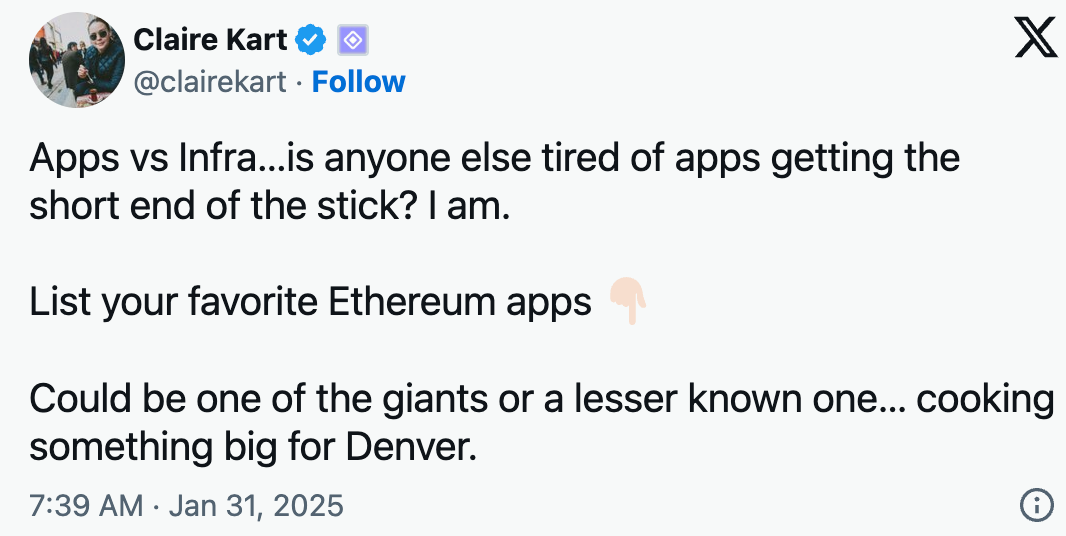
Figure 1: Claire Kart, Chief Marketing Officer of Aztec Network
But things are not always what they seem. What if what we thought about venture capital preferences was wrong? What if, in fact, consumer projects are the ones that benefit more?
Web3 Funding: A Problem of Definition
In the venture capital world, the general perception is that infrastructure projects have received a lot of attention from investors, and that “infrastructure” seems to dominate the venture capital market, leaving consumer projects underfunded.

Figure 2: Hira Siddiqui, founder of Plurality Network
In this discussion, it is necessary to first define the basic concepts. Perhaps part of the dispute and friction between the two sides is due to the confusion between "consumer projects" and "infrastructure projects". The following are the definitions of these two types of projects.
- Consumer projects : These projects aim to interact directly with end users and provide tools, services or platforms that meet personal or retail needs. Consumer projects usually focus on improving user experience, providing financial services, promoting entertainment, enhancing community participation, etc. End users are the main consumer group of these projects. These solutions are usually easier to use, prioritize the immediate needs of individuals or businesses, and do not require users to have too much technical background.
- Infrastructure projects : These projects are the foundation of decentralized systems and focus on building the core technology layers that support secure, scalable, and interoperable networks. They include technologies such as blockchain protocols, verification systems, and cross-chain interoperability to support the operation of other applications and services. The underlying infrastructure is often invisible to end users, but is critical to the performance and reliability of the entire system. These projects are mainly aimed at developers, node operators, and those responsible for maintaining and expanding blockchain systems.
Based on Messari’s fundraising data, industry project classification does not need to be redefined and can be directly applied to the existing framework.
Consumer application projects include: consulting and advisory services, cryptocurrency, data, entertainment, financial services, governance, HR and community tools, investment management, marketplaces, metaverse and games, news and information, security, synthetic assets, and wallets.
Infrastructure projects include: Networking & Web Services, Node Tools, Cross-Chain Interoperability, Networking, Physical Infrastructure Network, Computing Network, Mining & Validation, Developer Tools, and Consumer Infrastructure.
It is important to note that the category of "consumer infrastructure" is a bit fuzzy. It is the framework that supports user-facing applications but is not necessarily directly visible. For the purpose of this article, "consumer infrastructure" will be considered infrastructure projects.
The significance of the debate
Why is this debate so important? Why do founders and investors feel the need to draw a line on this issue? Blockworks’ Boccaccio, 6th Man Ventures’ Mike Dudas, and Dragonfly’s Haseeb Qureshi recently briefly explored this question during a panel discussion at the 2025 DAS conference in New York, but the brief exchange between the three was not enough to resolve the issue.

Figure 3: New York Digital Asset Summit, “Does Venture Capital Still Matter?” , Boccaccio (left), Haseeb Qureshi (center), Mike Dudas (right).
Infrastructure proponents believe they are the "invisible architects" of the on-chain future, and that digital railroads must be laid before consumers can move at high speed. Without adequate scalability to handle traffic surges and tight security protections to prevent attacks and vulnerabilities, widespread adoption is just talk. As Haseeb Qureshi said during the panel discussion: "Have we built blockchain? Is this the final form? If we want more than 10 million people to use public chains, we are not done yet."
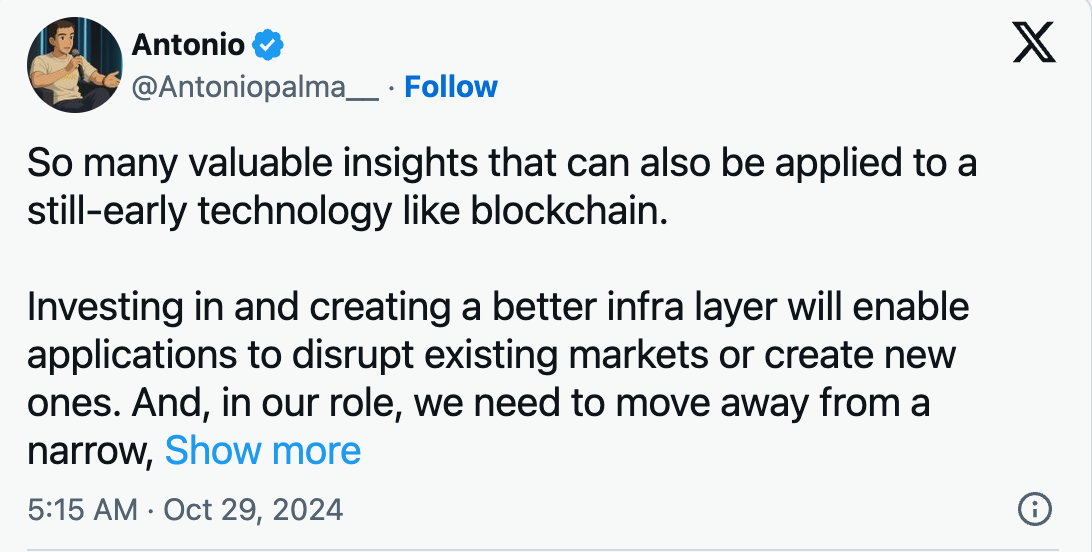
Figure 4: Antonio Palma
Through investment in technology R&D, the goal is to simplify the construction process, reduce friction for the next dApp creator, and ultimately enable widespread interaction between blockchain and users. This is not just a short-term bet, but a long-term plan: building infrastructure to pave the way for the smooth delivery of powerful consumer dApps.
On the other hand, supporters of consumer projects criticize the existing system for being heavily biased towards infrastructure projects. Even the most successful consumer applications are considering turning to the infrastructure field: Uniswap is building a modular AMM framework, Coinbase has launched its own L2, and even social applications like Farcaster have begun to position themselves as social protocols.
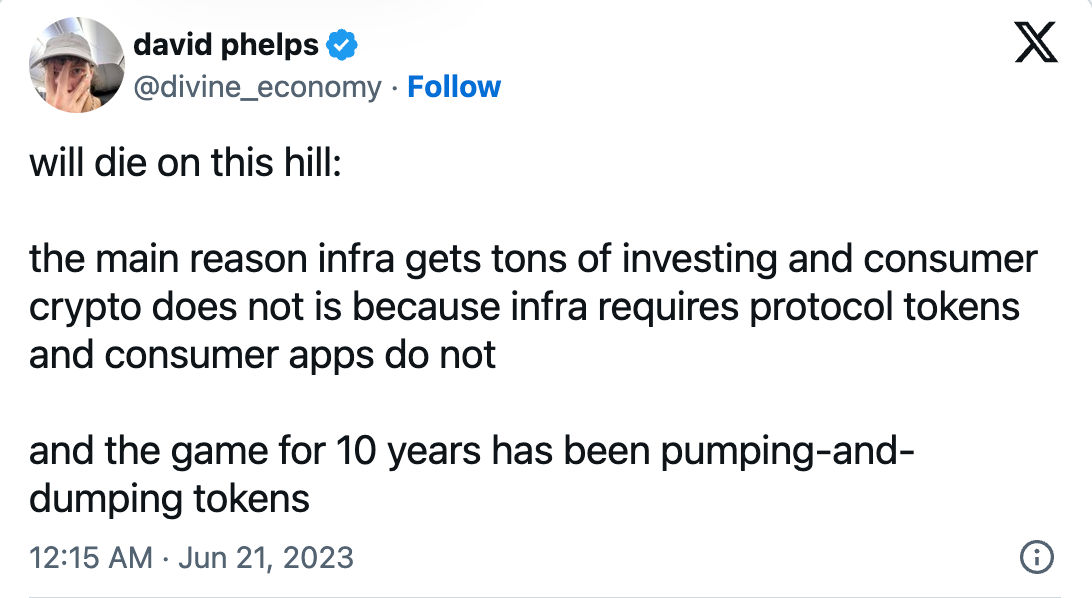
Figure 5: JokeRace co-founder David Phelps
As Mike Dudas said during the panel discussion, the current structure of the market means that infrastructure projects are by default “darlings” in the eyes of venture capitalists, even though the actual liquidity involved in these projects is not high.
Therefore, supporters of consumer projects argue that the role of venture capital is an artificial market distortion: if more capital can be allocated to consumer applications, then mass adoption can be achieved. Cumbersome wallets and complex interfaces are the biggest barriers to entry, making the most powerful blockchains almost invisible to the public. What can really drive the market is the "killer application". Although efficient and secure infrastructure is essential, no one will buy a ticket if the seat is uncomfortable and the journey is poor.
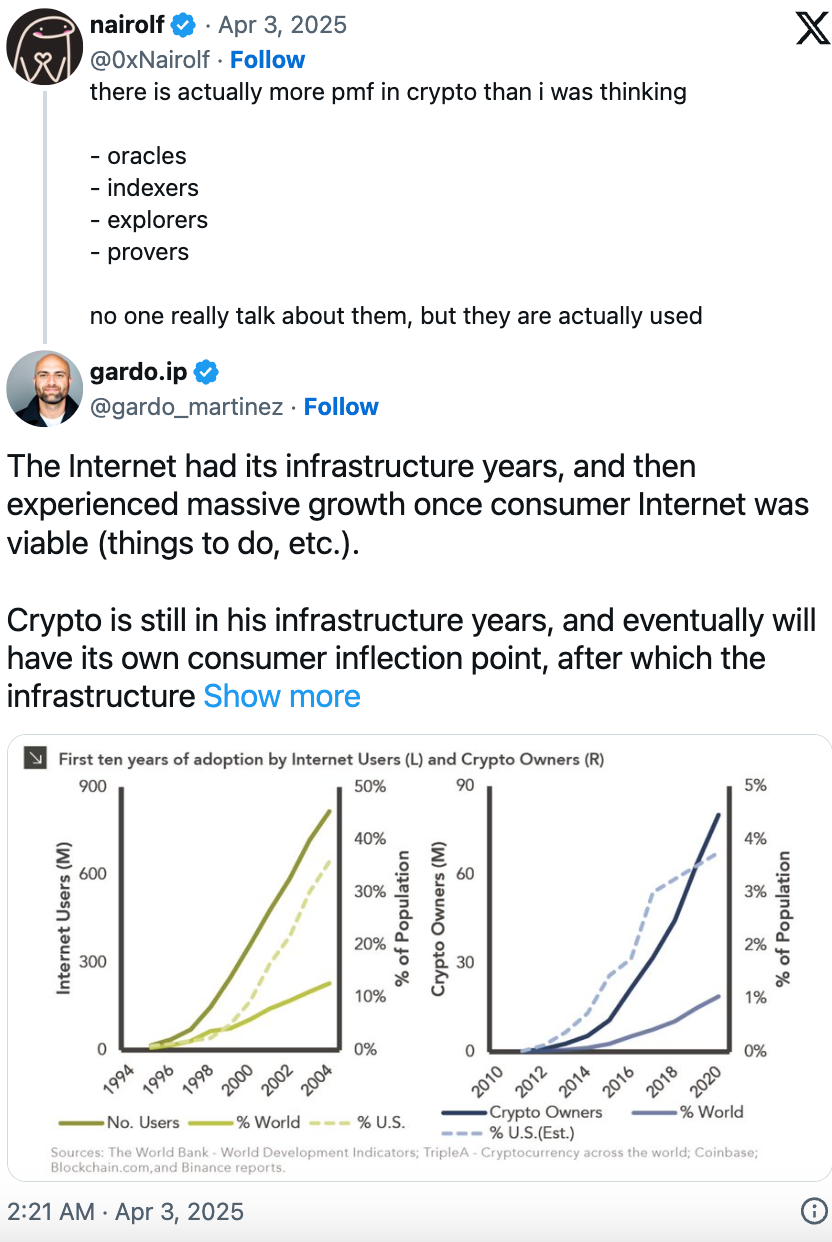
Figure 6: Gardo Martinez, Senior Product Manager at Story Protocol
The financing structure of Web3 has always been dominated by a common assumption: infrastructure projects should receive more capital support. The logic behind this view is that Web3 is still in its early stages of development and the underlying infrastructure is not yet fully mature, so the market will pay more attention to infrastructure projects than consumer-oriented applications.
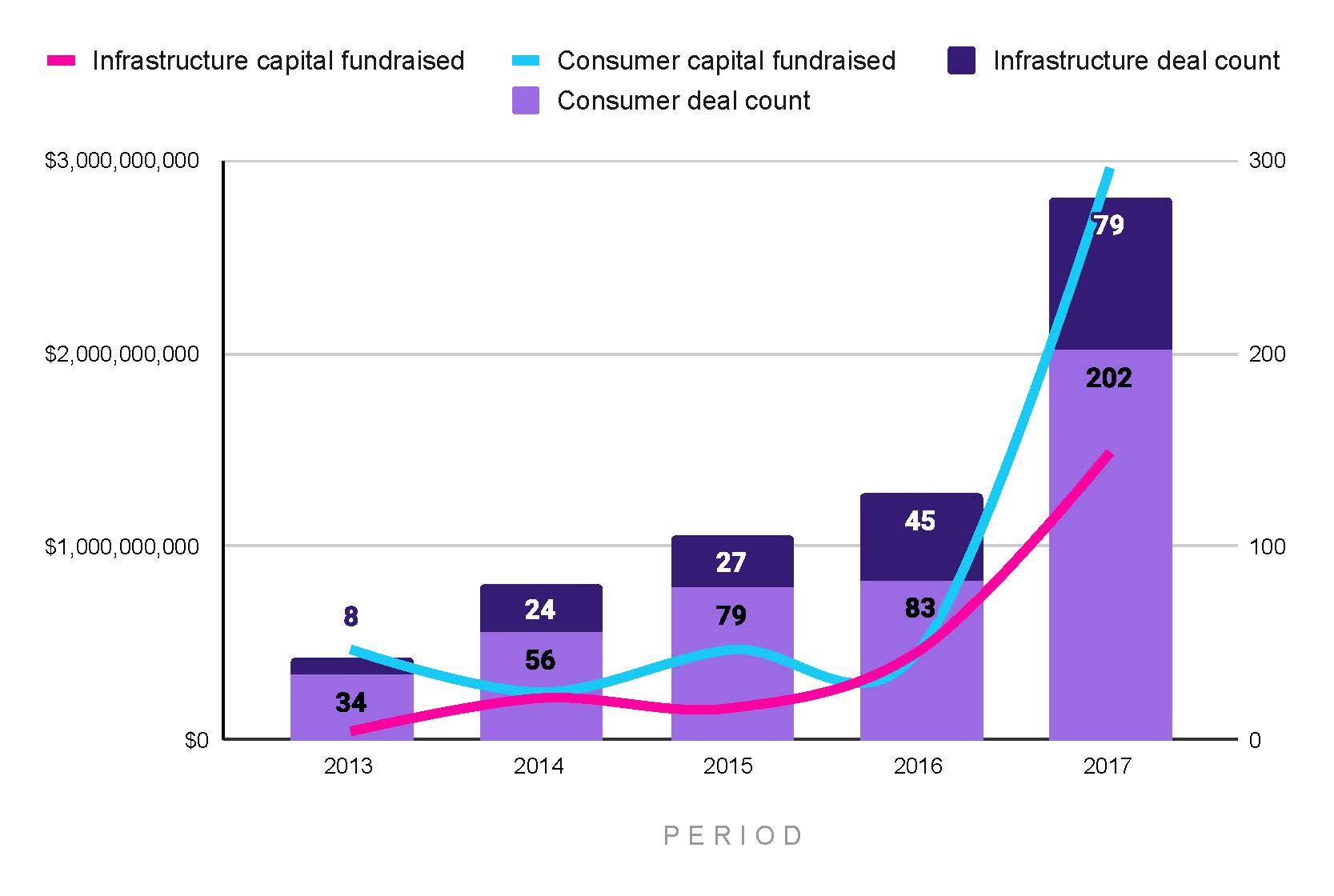
Figure 7: Financing amount and number of transactions in consumer goods and infrastructure projects at different stages, 2013-2017
However, early data reveals another trend (see Figure 7). Starting from 2013, from 2013 to 2017, 72% of financing transactions came from consumer projects, while infrastructure projects accounted for only 33% of the total financing. Although the two types of projects were once equal in total financing amounts in 2014 and 2016, the number of consumer projects that successfully raised funds in those years was still higher, which shows that although infrastructure projects have fewer financing rounds, the amount of each round is larger (see Figure 12). By 2017, consumer projects once again dominated Web3 venture capital.
Overall, the capital investment during this period is just a drop in the bucket compared to the scale of the following years, and cannot constitute the core support of the Web3 ecosystem. Because of the limited data sample, the analysis of this stage is independent of the main discussion. From 2018 to 2024, a large amount of capital poured in, and the early venture capital interest was just a drop in the ocean in comparison.
Even so, the preliminary data raise some key questions: Are infrastructure projects really getting more funding than consumer projects, or is the perception based on a false premise?
Is there a preference for consumer items?
Looking at Web3 funding data from 2018 to 2024, there is a recent trend of infrastructure projects receiving extra attention, while consumer applications are favored by more investors.
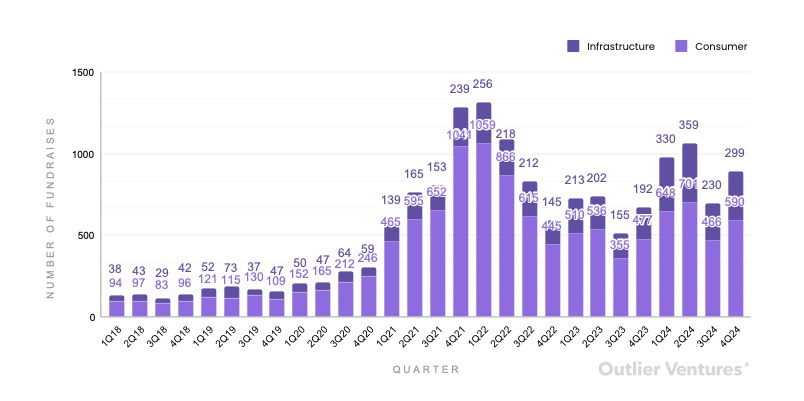
Figure 8: Total number of projects financed by infrastructure and consumer goods project categories by quarter, 2018-2024
Consumer applications account for 74% of all financing transactions from 2018 to 2024. Even in 2023 and 2024, consumer applications still account for 68% of all financing transactions (see Figure 8).
However, in terms of total funding, the fortunes of infrastructure projects have changed. From 2018 to 2020, infrastructure projects lagged behind consumer applications, with only 11% of capital going to infrastructure projects. In 2021, this trend began to change, although consumer projects still accounted for the majority of funding. In 2021 and 2022, infrastructure projects accounted for 19% of funding capital, while in 2023 and 2024, this proportion reached 25% and 43%, respectively (see Figure 9). In fact, from the fourth quarter of 2023 to the second quarter of 2024, infrastructure projects surpassed consumer projects in total funding. 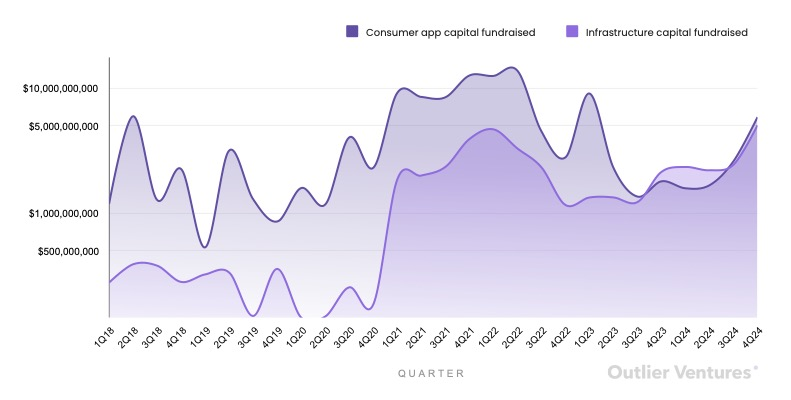
Figure 9: Total financing for consumer goods and infrastructure projects, quarterly, 2018-2014
Another dimension worth noting is investor participation. Although there is a view that most investors prefer infrastructure investment, the data from 2018 to 2024 shows that the number of investors participating in consumer projects is always higher. In particular, between 2021 and 2022, 79% of investor transactions appeared in consumer projects (see Figure 10).
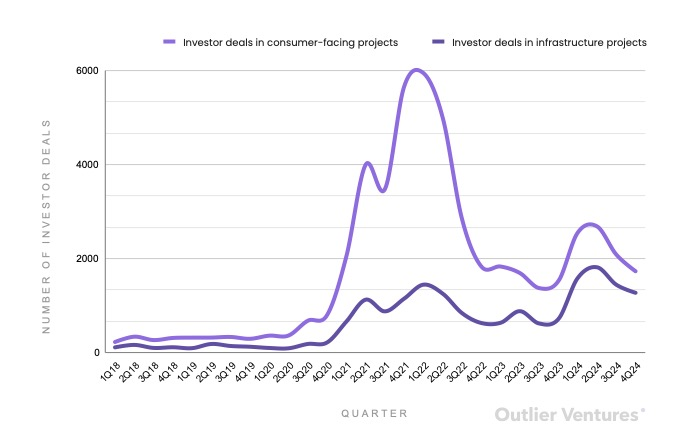
Figure 10: Total number of investor transactions in the consumer and infrastructure project categories by quarter, 2018-2024
Although there was a lag in the influx of capital into consumer projects at the beginning of the epidemic, this is consistent with the usual 6-9 month funding cycle. The epidemic lockdown has driven people’s attention and disposable income to shift online, thus stimulating a boom in Web3 consumer applications.
However, this craze was not long-lasting. The market crash in the second quarter of 2022 is generally believed to be triggered by the collapse of Terra/Luna in May. When UST was depegged, the market value evaporated by more than $40 billion in an instant, triggering a chain reaction. Large funds such as Three Arrows Capital and Celsius collapsed one after another, exposing the fragility of the DeFi system. Combined with macro pressures such as rising inflation, higher interest rates, and tightening liquidity, the entire crypto market fell into crisis. FTX's bankruptcy in November 2022 further exacerbated the collapse of market confidence.
From the perspective of venture capital, the crypto market rebound at the end of 2023 and in 2024 did not transmit to the VC market at the same time. The reason is that the market is still in the "hangover" stage after the consumption boom during the epidemic. The investment returns between the fourth quarter of 2020 and the fourth quarter of 2023 did not meet expectations, revealing the premature investment in consumer projects and the immaturity of crypto VC. Although the number of investor transactions in consumer projects is still leading, the gap between infrastructure projects and consumer projects has narrowed significantly. In 2024, infrastructure projects accounted for 40% of the number of investor transactions.
This is not a phenomenon unique to Web3. Between 2020 and 2021, a large amount of capital poured into the traditional VC market. Private equity investor "@carrynointerest" pointed out that the capital misallocation at this stage will lead to a long-term wave of VC failures. The lack of M&A exits, rising interest rates, and declining software valuations have turned a large number of VC-backed companies into "orphans" or "zombie" companies.
If we compare the total amount of Web3 financing with the number of traditional VC unicorns, the trends of the two are highly similar (see Figure 11). As shown in Figures 8, 9, 10, and 12, consumer projects have long occupied a large share of capital and transactions. The failure of VC in the Web3 field is essentially the failure of consumer projects. Based on this understanding, investors should shift their focus to infrastructure. 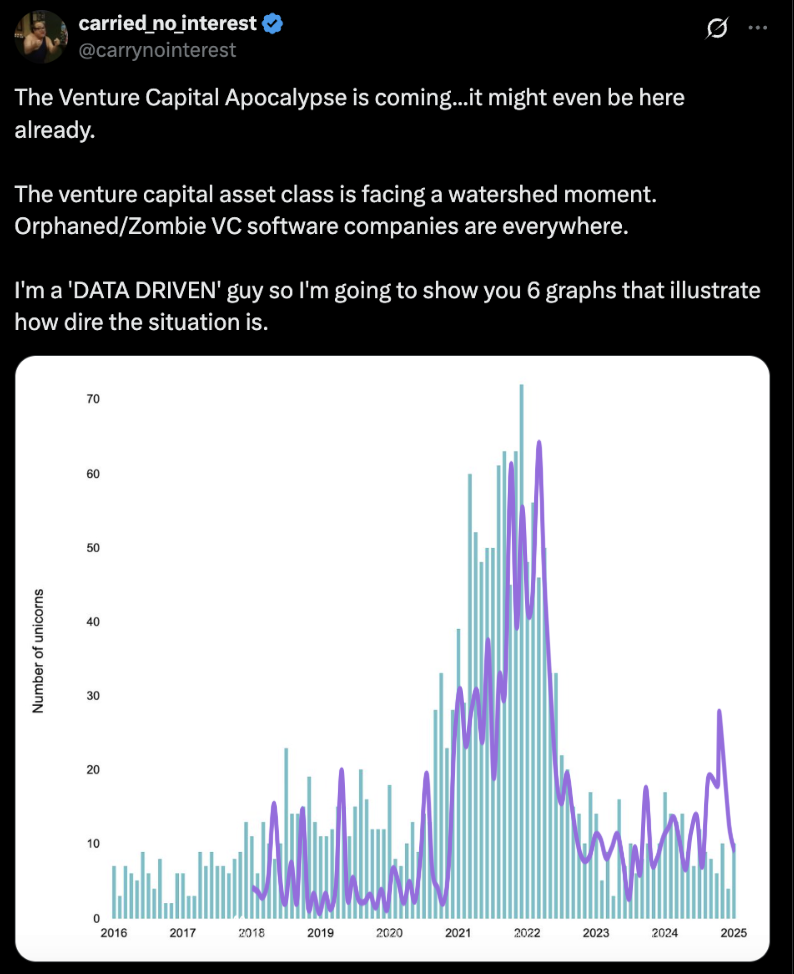
Figure 11: Number of startup unicorns and total funding raised by Web3 consumer and infrastructure projects between 2016 and 2025
But in reality, the adjustment of capital allocation to consumer projects is still limited. This is closely related to the financing mechanism of Web3. Unlike traditional equity, the token-based financing mechanism can achieve partial exit before the project is implemented, allowing investors to achieve certain returns even in the face of failed projects.
In addition, Web3 infrastructure projects often use longer lock-up and unlocking mechanisms due to their longer development cycles and higher requirements for protocol security and token economic models. Their tokens usually play a core role in network operations (such as staking or governance), so short-term concentrated unlocking must be avoided. In contrast, consumer projects pursue market speed, user growth, and early liquidity, and often design shorter lock-up cycles to quickly capture market heat and speculative demand.
This structural difference brings about a circular effect of capital: the early liquidity brought by a consumer project will feed back to the next project, thereby continuously promoting investment in the track and buffering the impact of failure. Because of this, the Web3 VC market has avoided the drastic corrections experienced by traditional VCs to a certain extent.
As a supplementary indicator, the total amount of financing can be combined with the number of financings to calculate the median round size of consumer and infrastructure projects, and combined with the number of investor transactions to depict the financing paths of the two (see Figure 12).
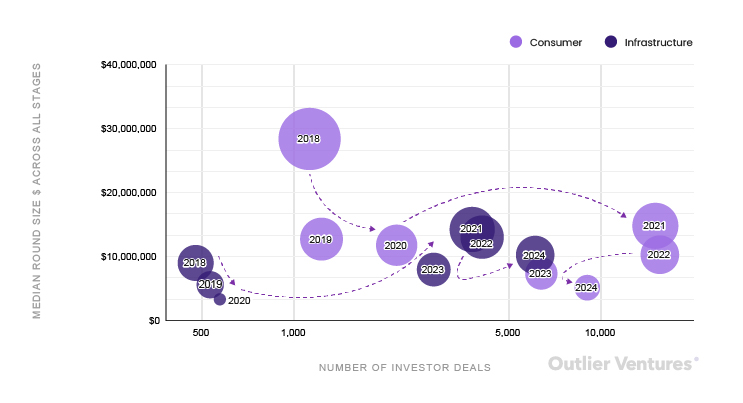
Figure 12: Median financing rounds for consumer goods and infrastructure projects at each stage from 2018 to 2024 and the corresponding annual number of investor transactions
- Consumer projects dominated the market from 2018 to 2020. In 2021, the median financing size of the two types of projects was close for the first time (US$14.8 million for consumer and US$14.2 million for infrastructure), but the number of transactions by investors in consumer projects was still four times that of infrastructure.
- Starting in 2022, median infrastructure round size surpassed consumer for the first time ($13 million vs. $11 million), and this trend continued until 2024.
- In 2024, the median financing size of infrastructure projects will be twice that of consumer projects.
Despite the continuous increase in infrastructure financing, the number of investor transactions in consumer projects remains the highest. In 2024, the number of investor transactions in this category will be 50% more than that in infrastructure. This shows that consumer projects are rich in variety and still attractive (see Figures 9 and 10).
Risk Appetite Index
In order to measure venture capital preferences more systematically, the study introduced a "risk preference index" (see Figure 13), which integrates the capital share, transaction volume share and investor share, with a score range of 0 to 1, and 0.5 is a neutral value. The weights of the three indicators are: capital share 50%, transaction volume 30%, and investor share 20%. Among them, capital share is the strongest signal, representing a high degree of due diligence and strong expectations; the number of transactions reflects the breadth of the market, but the size of a single transaction varies greatly; the number of investors reveals the market heat, although the signal-to-noise ratio is low.
So far, the index has not seen infrastructure projects score higher than consumer projects. The closest was in the first quarter of 2024, when infrastructure scored 0.48. Essentially, the index can be seen as a barometer of VC confidence.

Figure 13: Risk Appetite Score
Rethinking capital allocation for Web3 financing
There is no "right" answer to the ratio of funding for consumer vs. infrastructure projects, as it depends on the maturity of the market, staged needs, and environmental changes. In emerging technology ecosystems such as Web3, it is natural for infrastructure projects to attract a lot of capital in the early stages. The infrastructure layer takes longer to build and often has a "winner takes all" dynamic, which makes large-scale centralized investment a reasonable choice. Infrastructure unlocks scale, performance, and security, all of which are prerequisites for achieving mass consumer adoption. In this context, it seems reasonable for venture capital to favor infrastructure.
However, the data tells a different story. Venture capital has been favoring consumer projects, and the market is acting as if the infrastructure problem has been solved, at least for now.
This mismatch raises important questions. Did the industry turn its attention to consumer applications too early, without adequately testing the infrastructure? Did we focus too much on short-term liquidity in capital allocation, while neglecting long-term robustness? Or did we underestimate the existing maturity of the infrastructure, and instead overlook the user experience aspects that will drive mass adoption?
These are not binary choices, and in Web3, capital allocation should reflect the true maturity of the ecosystem, not the state we wish it to be. The path forward is not about taking sides, but about recalibrating confidence with reality.












